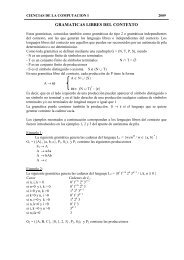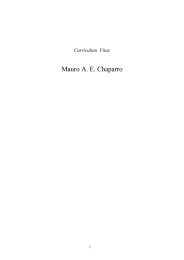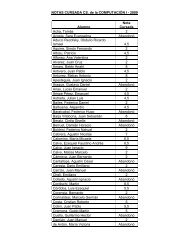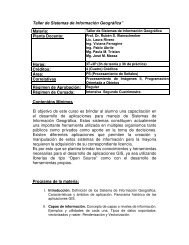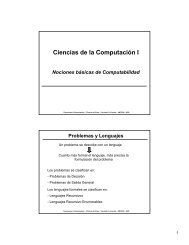Libro de Resúmenes / Book of Abstracts (Español/English)
Libro de Resúmenes / Book of Abstracts (Español/English)
Libro de Resúmenes / Book of Abstracts (Español/English)
You also want an ePaper? Increase the reach of your titles
YUMPU automatically turns print PDFs into web optimized ePapers that Google loves.
Resumenes 28<br />
Computational simulation to <strong>de</strong>termine thermal<br />
properties <strong>of</strong> soybean as a function <strong>of</strong> the drying<br />
process<br />
Knowing the drying kinetics, as well as the parameters and thermal<br />
properties that characterize the drying process <strong>of</strong> the agricultural products<br />
has become important in supporting the implantation <strong>of</strong> technologies to<br />
improve the conservation <strong>of</strong> these products. This experimental research<br />
area has shown improvements all over the world, as can be found in the<br />
specific post-harvest technology literature. Particularly at College <strong>of</strong><br />
Agricultural Engineering at University <strong>of</strong> Campinas, located in Brazil and<br />
known as FEAGRI/UNICAMP, pioneer-research work has been carried out<br />
using also applied mathematical as an important tool by Ito, Amendola and<br />
Park (2002). The main purpose <strong>of</strong> using this methodology is to compare its<br />
theoretical results with experimental data, in the least square method<br />
sense, in or<strong>de</strong>r to be able to i<strong>de</strong>ntify the thermal conductivity <strong>of</strong> the<br />
product. The experimental data consi<strong>de</strong>red in this investigation were<br />
selected from those recor<strong>de</strong>d previously to the soybean [1]. In this case, to<br />
perform the experiment, it was constructed a cylindrical equipment to place<br />
the product to be dried in such way that the process occurs in the spatial<br />
domain <strong>de</strong>fined between two cylin<strong>de</strong>rs with radii R1 = 0.013 [m] and R2 =<br />
0.0.049[m], subject to a heat source, qf = 393.7 [W/m 2 ], placed at its<br />
central axis. For a certain height <strong>of</strong> the equipment and at four positions<br />
along this radial domain the values <strong>of</strong> soybean temperature, T [°C], were<br />
recor<strong>de</strong>d along the time, t [s], approximately at each 100s during 6000s.<br />
The following fixed parameters <strong>of</strong> the process or product must be<br />
established: initial temperature T0 [°C], <strong>de</strong>nsity ρ [kg/m 3 ] and heat capacity<br />
Cp [J/kg°C]. The mathematical mo<strong>de</strong>l consi<strong>de</strong>red is the one-dimensional<br />
mathematical mo<strong>de</strong>l based on Fourier’s law second equation in cylindrical<br />
coordinates, un<strong>de</strong>r initial and boundary conditions according to the specific<br />
experiment <strong>de</strong>scribed previously but the algorithm is elaborated according<br />
to the scheme implicit <strong>of</strong> the finite differences method as recommen<strong>de</strong>d [2],<br />
once this investigation involves several simulations till reach the best value<br />
<strong>of</strong> the conductivity thermal, k [W/m°C], and is carried out for all the<br />
referred 4 positions. To <strong>de</strong>termine the referred best value it is necessary to<br />
know some value <strong>of</strong> k in or<strong>de</strong>r to initialize the search for the minimal<br />
residual value, which is taken from the literature. The whole algorithm was<br />
implemented with MATLAB6.5. We notice that this kind <strong>of</strong> problem, as it is a<br />
problem inverse, is ill posed and, for that, it requires a regularization<br />
technique, which is still being in <strong>de</strong>velopment<br />
References<br />
[1] ITO, A. P., AMENDOLA, M e PARK, K. J. Construção e avaliação <strong>de</strong> um<br />
sistema <strong>de</strong> <strong>de</strong>terminação <strong>de</strong> condutivida<strong>de</strong> e difusivida<strong>de</strong> térmica em regime<br />
transiente. In: Congreso Agronômico De Chile y Congreso Ibero Americano<br />
<strong>de</strong> Tecnología Postcosecha y Agronegócios, 3. Resumen. Simiente, v. 72 (3-<br />
4). ISSN 0037 - 5403. Santiago – Chile. 2002. p.141-142.<br />
[2] MENDOLA, M. Consi<strong>de</strong>rations to continue researches in drying process<br />
numerical simulation <strong>of</strong> agriculture products at FEAGRI/UNICAMP. Abstract



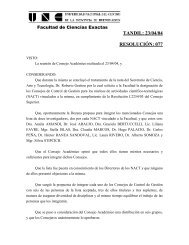
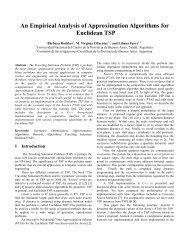
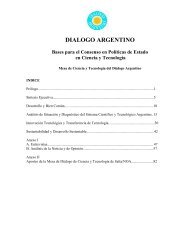
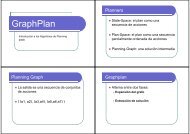
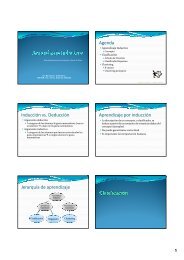
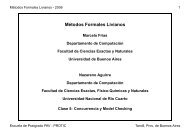
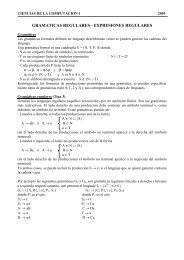

![Clase 13 [pdf]](https://img.yumpu.com/19616969/1/190x245/clase-13-pdf.jpg?quality=85)

